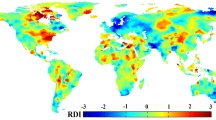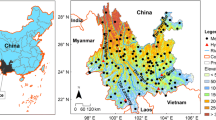Abstract
Effective drought prediction methods are essential for the mitigation of adverse effects of severe drought events. This study utilizes the Reconnaissance Drought Index, Standardized Precipitation Index and Standardized Precipitation Evapotranspiration Index to assess the occurrence of future drought events in the study area of the Heilongjiang province of China over a period of 2016–2099. The drought indices were computed from the meteorological data (temperature, precipitation) generated by the global climate model (HadCM3A2). Moreover, Mann-Kendall trend test was applied for the assessment of future climatic trends and detecting probable differences in the behaviour of various drought indices. Drought forecasting periods has been divided into three categories: the early phase (1916–2030), middle phase (2031–2060) and late phase (2061–2099). The occurrence of future droughts is also ranked according to their intensity (mild, moderate, severe and extreme drought). Based on the drought results, more number of drought events are expected to occur during 12-month drought analysis are, RDI during 2084–2098 (DD = 14, DS = −1.38), SPEI during 2084–2098 (DD = 14, DS = −1.33) and SPI during 2084–2095 (DD = 12, DS = −1.19). The 1st and 2nd months of the years studied predicted a warming trend, while the 7th, 8th, and 9th months predicted a wetter trend. Finally, it was observed that RDI is more sensitive to drought and indicated a high percentage of years under severe and extreme drought conditions during the drought frequency analysis. Conclusively, this study provides a strategies for water resources management and monitoring of droughts, in which drought indices like RDI can play a central role.






Similar content being viewed by others
References
Banimahd SA, Khalili D (2013) Factors influencing Markov chains predictability characteristics, utilizing SPI, RDI, EDI and SPEI drought indices in different climatic zones. Water Resour Manag 27(11):3911–3928
Blain GC (2012) Revisiting the probabilistic definition of drought: strengths, limitations and an agro meteorological adaptation. Bragantia 71(1):132–141
Bonaccorso B, Bordi I, Cancelliere A, Rossi G, Sutera A (2003) Spatial variability of drought: an analysis of the SPI in Sicily. Water Resour Manag 17(4):273–296
Burke EJ, Brown SJ (2008) Evaluating uncertainties in the projection of future drought. J Hydrometeorol 9(2):292–299
Chen H, Xu CY, Guo S (2012) Comparison and evaluation of multiple GCMs, statistical downscaling and hydrological models in the study of climate change impacts on runoff. J Hydrol 434:36–45
Chu JT, Xia J, Xu CY, Singh VP (2010) Statistical downscaling of daily mean temperature, pan evaporation and precipitation for climate change scenarios in Haihe River, China. Theor Appl Climatol 99(1–2):149–161
Cook BI, Smerdon JE, Seager R, Coats S (2014) Global warming and 21st century drying. Clim Dyn 43(9–10):2607–2627
Davey M, Huddleston M, Sperber K, Braconnot P, Bryan F, Chen D, Colman R, Cooper C, Cubasch U, Delecluse P, DeWitt D (2002) STOIC: a study of coupled model climatology and variability in tropical ocean regions. Clim Dyn 18(5):403–420
Edwards DC (1997) Characteristics of 20th century drought in the United States at multiple time scales (no. AFIT-97-051). Air force Inst of tech Wright-Patterson AFB OH
Elagib NA, Elhag MM (2011) Major climate indicators of ongoing drought in Sudan. J Hydrol 409(3):612–625
Ellis AW, Goodrich GB, Garfin GM (2010) A hydro climatic index for examining patterns of drought in the Colorado River basin. Int J Climatol 30(2):236–255
Gordon C, Cooper C, Senior CA, Banks H, Gregory JM, Johns TC, Mitchell JF, Wood RA (2000) The simulation of SST, sea ice extents and ocean heat transports in a version of the Hadley Centre coupled model without flux adjustments. Clim Dyn 16(2):147–168
Hao Z, Singh VP (2012) Entropy-based method for bivariate drought analysis. J Hydrol Eng 18(7):780–786
Hao Z, AghaKouchak A, Nakhjiri N, Farahmand A (2014) Global integrated drought monitoring and prediction system. Sci Data, 1
Hayes MJ, Svoboda MD, Wilhite DA, Vanyarkho OV (1999) Monitoring the 1996 drought using the standardized precipitation index. Bull Am Meteorol Soc 80(3):429–438
Ke LIU, Da-Bang JIANG, Jian-Yong MA (2012) Drought over China in the 21st century: results of RegCM3. Atmospheric and Oceanic Science Letters 5(6):509–513
Kendall MG (1975) Rank correlation methods. Griffin, London
Khalili D, Farnoud T, Jamshidi H, Kamgar-Haghighi AA, Zand-Parsa S (2011) Comparability analyses of the SPI and RDI meteorological drought indices in different climatic zones. Water Resour Manag 25(6):1737–1757
Khan MI, Liu D, Fu Q, Dong S, Liaqat UW, Faiz MA, Hu Y, Saddique Q (2016) Recent climate trends and drought behavioral assessment based on precipitation and temperature data series in the Songhua River basin of China. Water Resour Manag 30(13):4839–4859
Kim DW, Byun HR (2009) Future pattern of Asian drought under global warming scenario. Theor Appl Climatol 98(1–2):137–150
Mann HB (1945) Nonparametric tests against trend. Journal of the Econometric Society, Econometrica, pp 245–259
McKee TB, Doesken NJ, Kleist J (1993) The relationship of drought frequency and duration to time scales. In: Proceedings of the 8th Conference on Applied Climatology, vol 17. Boston: American Meteorological Society, no. 22, pp 179–183
Mishra AK, Singh VP (2010) A review of drought concepts. J Hydrol 391(1):202–216
Palmer WC (1965) Meteorological drought (Vol. 30). US Department of Commerce, Weather Bureau, Washington, DC
Pearson K (1896) Mathematical contributions to the theory of evolution. III. Regression, heredity, and panmixia. Philosophical transactions of the Royal Society of London. Series A, Containing Papers of a Mathematical Physical Character 187:253–318
Seager R, Ting M, Held I, Kushnir Y, Lu J, Vecchi G, Huang HP, Harnik N, Leetmaa A, Lau NC, Li C (2007) Model projections of an imminent transition to a more arid climate in southwestern North America. Science 316(5828):1181–1184
Shafer BA, Dezman LE (1982) Development of a surface water supply index (SWSI) to assess the severity of drought conditions in snowpack runoff areas. In: Proceedings of the western snow conference, vol 50. Colorado State University, Fort Collins, pp 164–175
Shokoohi A, Morovati R (2015) Basinwide comparison of RDI and SPI within an IWRM framework. Water Resour Manag 29(6):2011–2026
Sun Q, Miao C, Duan Q (2015) Projected changes in temperature and precipitation in ten river basins over China in 21st century. Int J Climatol 35(6):1125–1141
Taylor IH, Burke E, McColl L, Falloon P, Harris GR, McNeall D (2012) Contributions to uncertainty in projections of future drought under climate change scenarios. Hydrol Earth Syst Sci Discuss 9(12):613–612
Thornthwaite CW (1948) An approach toward a rational classification of climate. Geogr Rev 38(1):55–94
Tigkas D, Vangelis H, Tsakiris G (2012) Drought and climatic change impact on stream flow in small watersheds. Sci Total Environ 440:33–41
Tigkas D, Vangelis H, Tsakiris G (2013) The RDI as a composite climatic index. European Water 41:17–22
Tigkas D, Vangelis H, Tsakiris G (2015) DrinC: a software for drought analysis based on drought indices. Earth Sci Inf 8(3):697–709
Tsakiris G, Vangelis H (2005) Establishing a drought index incorporating evapotranspiration. European Water 9(10):3–11
Tsakiris G, Pangalou D, Vangelis H (2007a) Regional drought assessment based on the reconnaissance drought index (RDI). Water Resour Manag 21(5):821–833
Tsakiris G, Loukas A, Pangalou D, Vangelis H, Tigkas D, Rossi G, Cancelliere A (2007b) Drought characterization. Drought management guidelines technical annex, pp 85–102.
Tsakiris G, Nalbantis I, Pangalou D, Tigkas D, Vangelis H (2008) Drought meteorological monitoring network design for the reconnaissance drought index (RDI). In Proceedings of the 1st international conference “drought management: scientific and technological innovations”, vol 80. Zaragoza: option Méditerranéennes, series a, pp 12–14
Vangelis H, Spiliotis M, Tsakiris G (2011) Drought severity assessment based on bivariate probability analysis. Water Resour Manag 25(1):357–371
Vangelis H, Tigkas D, Tsakiris G (2013) The effect of PET method on reconnaissance drought index (RDI) calculation. J Arid Environ 88:130–140
Vicente-Serrano SM, Beguería S, López-Moreno JI (2010) A multiscalar drought index sensitive to global warming: the standardized precipitation evapotranspiration index. J Clim 23(7):1696–1718
Vicente-Serrano SM, Lopez-Moreno JI, Beguería S, Lorenzo-Lacruz J, Sanchez-Lorenzo A, García-Ruiz JM, Azorin-Molina C, Morán-Tejeda E, Revuelto J, Trigo R, Coelho F (2014) Evidence of increasing drought severity caused by temperature rise in southern Europe. Environ Res Lett 9(4):–044001
Von Storch H (1999) The global and regional climate system. In Anthropogenic Climate Change. Springer, Berlin Heidelberg, pp 3–36
White P, Hilario FD, Guzman RD, Cinco TA, Abery NW, Silva SS (2010) A review of climate change model predictions and scenario selection. Aqua Climate 29
Wilby RL, Wigley TML, Conway D, Jones PD, Hewitson BC, Main J, Wilks DS (1998) Statistical downscaling of general circulation model output: a comparison of methods. Water Resour Res 34(11):2995–3008
Wilby RL, Dawson CW, Barrow EM (2002) SDSM—a decision support tool for the assessment of regional climate change impacts. Environ Model Softw 17(2):145–157
Wilby RL, Charles SP, Zorita E, Timbal B, Whetton P, Mearns LO (2004) Guidelines for use of climate scenarios developed from statistical downscaling methods. Supporting material of the intergovernmental panel on climate change, available from the DDC of IPCC TGCIA, p 27
Wilhite DA (ed) (2012) Drought assessment, management, and planning: theory and case studies: theory and case studies, vol 2. Springer Science & Business Media
Wu H, Hayes MJ, Wilhite DA, Svoboda MD (2005) The effect of the length of record on the standardized precipitation index calculation. Int J Climatol 25(4):505–520
Xiu Jun L (2000) The Alkili-saline land and agricultural sustainable development of the western Songnen plain in China. Sci Geogr Sin 20(1):51–55
Zarch MAA, Malekinezhad H, Mobin MH, Dastorani MT, Kousari MR (2011) Drought monitoring by reconnaissance drought index (RDI) in Iran. Water Resour Manag 25(13):3485
Zarch MAA, Sivakumar B, Sharma A (2015) Droughts in a warming climate: a global assessment of standardized precipitation index (SPI) and reconnaissance drought index (RDI). J Hydrol 526:183–195
Zargar A, Sadiq R, Naser B, Khan FI (2011) A review of drought indices. Environ Rev 19:333–349
Acknowledgements
This study is supported by the National Natural Science Foundation of China (No.51579044, No.41071053, No.51479032), Specialized Research Fund for Innovative Talents of Harbin (Excellent Academic Leader) (No.2013RFXXJ001), Science and Technology Program of Water Conservancy of Heilongjiang Province (No.201319, No.201501, No.201503).
Author information
Authors and Affiliations
Corresponding authors
Ethics declarations
Conflict of Interest
No conflict of interest.
Rights and permissions
About this article
Cite this article
Khan, M.I., Liu, D., Fu, Q. et al. Projected Changes of Future Extreme Drought Events under Numerous Drought Indices in the Heilongjiang Province of China. Water Resour Manage 31, 3921–3937 (2017). https://doi.org/10.1007/s11269-017-1716-4
Received:
Accepted:
Published:
Issue Date:
DOI: https://doi.org/10.1007/s11269-017-1716-4




